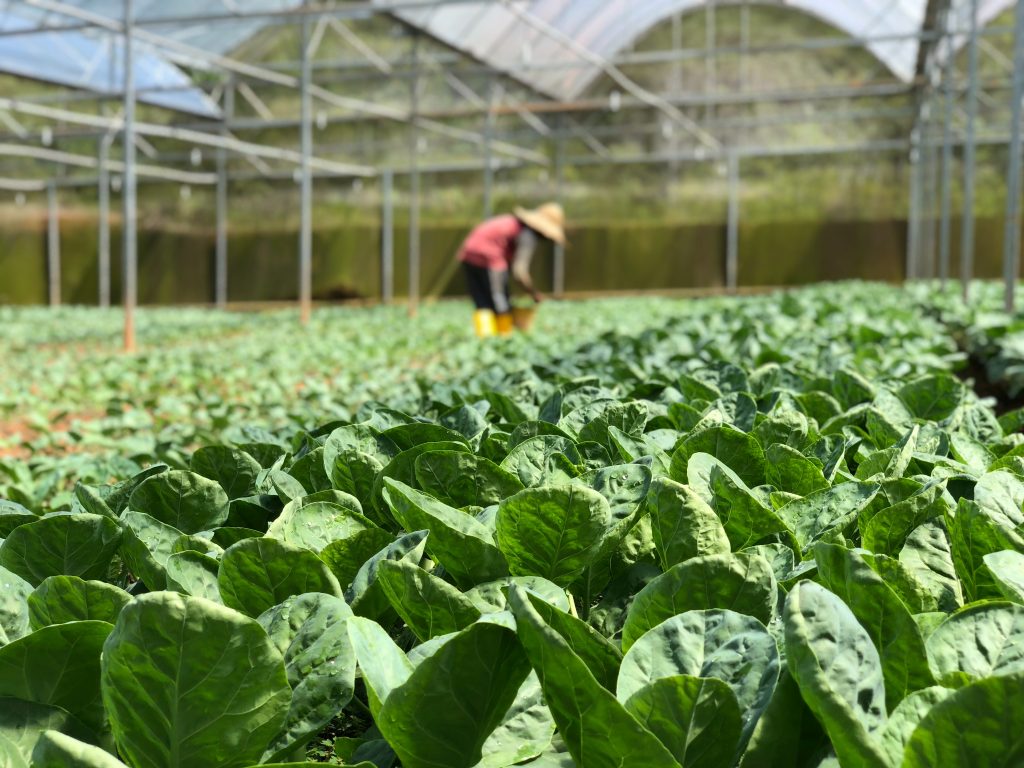
Greenhouse soil crops need more specialized care. When you grow plants out in the open field, your soil has time to rest and regenerate. Not so in the greenhouse, where the climate is much hotter and the soil and plants are working hard all year round. Greenhouse soil temperatures are higher and you need to pay special attention to its needs, so that it can reward you with happy, healthy plants and higher yields. This is important as you have to be able to make a profit to pay for the greenhouse!
Is the site suitable and flat? If you have to level the site, make sure you push the topsoil to the side, level the site and then return the topsoil. A common mistake is to level the soil by pushing the topsoil out of the way. Growing on exposed infertile sub-soil is an uphill battle.
Where will the extra water run off go when it rains, and will it take your greenhouse with it? Can you collect it in a reservoir? Rain water is great for greenhouse plants, but not flood water. Take a soil sample, for a complete soil analysis. You should get a base dressing recommendation with lime, dolomitic lime, gypsum, rock phosphate and/or manure application rates. It is much easier and cheaper to apply this now, before you plant your plants, and it helps your soil structure.
Do a nematode analysis. If you have a high count of plant parasitic nematodes it is a good idea to plant a green manure crop of brassicas to reduce the nematodes and increase the organic mature in the soil.

Get your irrigation water analysed – evaporation is much higher in greenhouses, and salts get left behind in the soil much faster than outside. Greenhouse soils are less salt tolerant and if your water has high sodium and high Electrical Conductivity (EC) you need to know at the start, as there are special ways to deal with this.
Dig a soil pit at least one meter deep and look for any hard pans or layers that plant roots and water cannot penetrate. Deep rip the soil in both directions to break through any compaction zones. If you have a small greenhouse double digging is highly recommended. Deep ripping or double digging should happen after your base dressing fertilizer application – so you can mix everything nice and evenly into the soil.
Plan your greenhouse layout properly and in advance with regards to beds, paths and drip lines, and get your plant density correct by discussing with your plant supplier. Too high a plant density and you will run into disease and quality problems, too low a plant density and your production will suffer.

Raised greenhouse soil beds are recommended. Mark out the soil beds and add the topsoil from the path onto the bed. Be careful, working with over wet soil will compact it. Your plants will benefit from a thicker layer of topsoil, air and water can move in and out of the sides of the bed, and salts can be leached away from the root zone, to the edge of the bed. Your plants will not get trampled so easily and the compaction caused by people and machines travelling up and down the beds will remain in the path.
It’s most important to buy clean, certified seeds or plants, so that you do not bring diseases or nematodes into your greenhouse. To further reduce risk, you can send some plant samples for an independent assessment.
Plants grown in greenhouses grow faster than outside and need to be ‘fed’ accordingly, whether topdressing solid fertilisers, or through the drip lines, with soluble fertilizers. It is recommended to do a 1:2 water extract analysis of the soil at the beginning of a program and every 3 months to assess and adjust the fertilizer program. Many farmers are tempted to over apply fertilizers to push up yields. It’s better to err on the side of caution and apply less, because it is easier to add fertilizer than to try and deal with an excess in the soil.
An ideal pH should be between 6 and 7. If the pH goes above 7, the plants cannot take up iron, even if it is there and they will suffer. If the pH falls below 6, the soil life reduces, and quite a few nutrients become ‘locked up’ or released to the environment. Either way, the soil and plants suffer. High soil Electrical Conductivity (EC) levels can build up extremely fast in greenhouses due to the high evapo-transpiration.
Once EC gets to a critical level the plants can no longer take up any fertilizer and the EC’s suddenly build up even faster. If your EC’s get too high flush the soils with lots of plain water, to wash the salts away from the root zone, this is why it is so important to have loose soil with no compaction zone. The white salt films that you often see in greenhouse soils are due to surface evaporation drawing salts up to the surface.

Soil aeration is essential for root activity and plant growth. Keep your soils light and un-compacted and do not over water! Oxygen should be considered a major nutrient for plants. So many times I have been in a greenhouse and the plants are wilting at midday, and the soils are too wet! The roots cannot take in the oxygen that they need to take the water up! Wilting plants don’t produce and they are much more likely to get diseases.
It is advisable to invest in a proper soil moisture monitoring device so that you can keep the soil oxygen/ water ratio at the optimum for plant growth and soil activity. Try not to irrigate at the end of the day and send your plants into the night with wet feet. This encourages diseases.
Organic matter is so important for proper soil and plant health and keeping to a good level can greatly reduce your pesticide and fertilizer costs, as well as helping the environment. Greenhouse soils are much hotter than the soils outside and the organic matter ‘burns off’ faster. It is excellent greenhouse practice to keep topping your soils up with good compost or manure.
It is so important to rotate your crops. This will reduce the pathogen and nematodes in the soil and will stimulate soil health. In the case of long term crops, like roses, even a short term green manure crop, will make a great difference and reduce the ‘tired soil syndrome’. Rotation helps in renewing greenhouse soil. Diseases build up very fast in greenhouses due to the heat, and many a project has failed due to lack of proper crop rotations.
Till next time,
happy farming!
Ruth

Ruth Vaughan is the Technical Director at Crop Nutrition Laboratory Services Ltd. (CROPNUTS). Ruth is also a contributing author to Kenya’s leading horticulture magazines such as the HortFresh Journal, HortiNews and Floriculture. Ruth is a great believer in soil health, organic matter, biochar and carbon sequestration as a way to alleviate climate change and increase food security. Loves visiting farmers and seeing all the different farming methods
Order our services and get to know how to improve your soil for better yeilds.